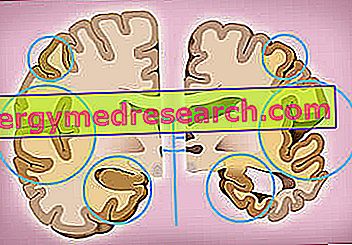Generality
Cerebral atrophy is the reduction of the encephalic tissue, deriving from the necrosis and / or the shrinking of the cells that constitute the aforementioned tissue.

Brain atrophy is a normal consequence of aging, but not only. In fact, it can also depend on various injuries and conditions of the brain, including: brain trauma, strokes, Alzheimer's disease, senile dementia, frontotemporal dementia, malnutrition, anorexia nervosa, encephalitis of infectious nature etc.
The possible symptomatological picture is very broad and depends on the area of encephalon involved.
For a correct diagnosis of brain atrophy, the images provided by tests such as nuclear magnetic resonance or the brain CT scan are essential.
Unfortunately, changes in brain tissue induced by brain atrophy are permanent. Therefore, no treatment available at the moment is able to restore the normal anatomy of the brain and restore the normal functions of the latter.
What is brain atrophy?
Cerebral atrophy is the mass reduction of the encephalic tissue, resulting from the necrosis and / or shrinkage of the cells that make up the aforementioned tissue.
Thus, brain damage leads to a numerical and / or functional decrease in the encephalic neurons, and a loss of the connections that these neurons establish between them.
Due to brain atrophy, the brain of the affected person loses a more or less substantial part of its functions. The load of lost functions depends on how extensive the brain atrophy is.
Medical meaning of atrophy
In medicine, the term atrophy indicates a reduction in the mass of a tissue or organ; this reduction is due to death (necrosis) or to the shrinking of the cells that make up the affected tissue or organ.
Necrosis and / or shrinkage are the final result of a progressive loss of cytoplasmic proteins.
TYPES OF CEREBRAL ATROPHY
Brain atrophy can affect the entire brain or some of its parts.
In the case in which the whole brain is concerned, it is defined by the term " generalized "; if it is located only in some portions of the brain, it is called focal .
Clearly, generalized cerebral atrophy jeopardizes all the functions of the brain, while focal cerebral atrophy only affects the functions of the brain areas that are victims of the atrophy process.
Causes
As we age, the human brain is a victim, inevitably and more or less markedly depending on the case, of a mass reduction in brain tissue. Aging, therefore, is the main cause of brain atrophy.
That said, brain atrophy is also a possible consequence of injuries or pathologies of the brain, including:
- Brain traumas . At the origin of most brain traumas are workplace accidents, motor vehicle accidents and head injuries during sports where physical contact is expected;
- Stroke episodes. The term stroke and its numerous synonyms - including stroke, apoplectic attack, cerebral infarction and stroke - indicate the death, due to insufficient blood supply, of a more or less extensive area of the brain;
- Alzheimer's disease . It is the most common type of dementia in the world. It determines a progressive and inexorable cognitive decline, which affects short-term and long-term memory, movement skills, abstraction of thought, language, judgment, personality and behavior;
- Senile dementia, frontotemporal dementia and vascular dementia ;
- Pick's disease . It is a particular subtype of frontotemporal dementia;
- Huntington's disease . It is a hereditary neurodegenerative disease, which occurs as a result of a mutation in the huntingtin protein gene. The peculiarity of this hereditary disease, present since birth, is that its symptoms appear between the ages of 30 and 40;
- Cerebral palsy ;
- Leukodystrophies, such as Krabbe's disease, which involve an incorrect metabolism of the myelin sheath of axons;
- Multiple sclerosis . It is a chronic and debilitating disease, which occurs due to the progressive degradation of myelin belonging to the neurons of the central nervous system;
- Severe epilepsy ;
- Malnutrition . Several scientists have shown that vitamin B12 deficiency is a condition often associated with brain atrophy;
- Anorexia nervosa, bulimia nervosa and other eating disorders ;
- Type II diabetes ;
- Mitochondrial encephalomyopathies, such as Kearns-Sayre syndrome . A mitochondrial encephalomyopathy is a particular form of encephalopathy, which is characterized by its permanent character and by the fact that it arises due to a congenital malfunction of mitochondria present in the cells of the organism concerned.
Furthermore, brain atrophy can be a consequence of infectious diseases, such as infectious encephalitis, neurosyphilis or AIDS, and the abuse of neuroleptic drugs or corticosteroids.
To know more
Readers interested in learning more about dementia (Alzheimer's disease, frontotemporal dementia, Huntington's disease, etc.) and the consequences of dementia in the brain can consult the article here.
CEREBRAL ATROPHY RISK FACTORS
Many of the main causes of brain atrophy, such as Alzheimer's disease, vascular dementia, senile dementia or stroke, are typical of old age.
Therefore, advanced age and aging in general can be considered not only the most important causes of brain atrophy, but also the most important risk factors.
Other risk factors of cerebral atrophy, worthy of a quotation, are: the practice of work or sports activities in which there is a high risk of head trauma, arteriosclerosis, the abuse of alcoholic substances (alcoholism) and a family history of Alzheimer's disease, Huntington's disease or similar neurological disorders.
Symptoms, signs and complications
The symptoms and signs of brain atrophy vary according to the area of encephalon affected by the processes of necrosis and shrinkage.
For example, if brain atrophy affects the occipital lobes, the patient suffers from visual problems; if it affects the temporal lobes, the patient manifests memory loss, language difficulties, mood swings, abnormal behavior, personality changes, poor understanding of sounds, etc.
From this it follows that every patient with cerebral atrophy represents a case in itself.
| Table of possible symptoms and signs of brain atrophy |
|
COMPLICATIONS
In those affected, advanced brain atrophy is responsible for several complications, including: the inability to perform the simplest daily activities and participate in the most normal social activities, the total lack of independence from others and one state of major depression .
Diagnosis
The presence of brain atrophy emerges, clearly and blatantly, from the execution of diagnostic tests such as the nuclear magnetic resonance of the brain and the CAT scan (or Computerized Axial Tomography) of the brain.
DIAGNOSIS OF CAUSES
During the diagnosis of brain atrophy, it is very important to identify the triggering causes. In fact, only thanks to the knowledge of the triggering causes, it is possible to plan the most appropriate therapy.
For the discovery of the causes triggering brain atrophy are fundamental: a thorough physical examination, a thorough medical history, a complete neurological examination, a cognitive and neuropsychological examination, and a series of laboratory analyzes.
Therapy
Unfortunately, the changes and events of necrosis that brain atrophy causes in the brain tissue are incurable and irreparable . Therefore, brain atrophy is a permanent condition, for which there is no possibility of reversion .
All this, however, does not exclude that there are treatments able to alleviate the symptoms of brain atrophy and treatments capable of slowing down or even stopping the inexorable progress of certain triggering conditions (such as stroke, Alzheimer's disease, malnutrition, anorexia nervosa or infectious encephalopathies).
To deepen the treatment of the factors that can cause brain atrophy and the latter's symptomatic therapy, readers can consult:
- Drugs for the treatment of Alzheimer's disease;
- Care and treatments for Alzheimer's disease;
- Drugs for the treatment of anorexia nervosa;
- Diet for anorexia nervosa;
- Drugs for the treatment of vascular dementia;
- Stroke treatment drugs.
EXAMPLES OF VALID THERAPIES FOR THE CARE OF CEREBRAL ATROPHY
Among the medical treatments able to alleviate the symptoms of brain atrophy, they deserve a quick quote: anticonvulsants, cognitive-behavioral psychotherapy, physiotherapy and the so-called language therapy
Prognosis
Being an incurable condition, brain atrophy can only always have an unfavorable prognosis.
Prevention
Unfortunately, brain atrophy is not preventable.
However, it is good to remember that controlling blood pressure, eating in a healthy and balanced way, limiting or avoiding alcohol consumption and keeping yourself mentally, physically and socially active are, according to the entire medical community, effective countermeasures in reducing or at least postponing the onset of brain atrophy.



